INSIDE THE BATMAN: The writer explores Detective Comics #472 — Exit Hugo Strange, enter Robin … and the Penguin and the Joker…
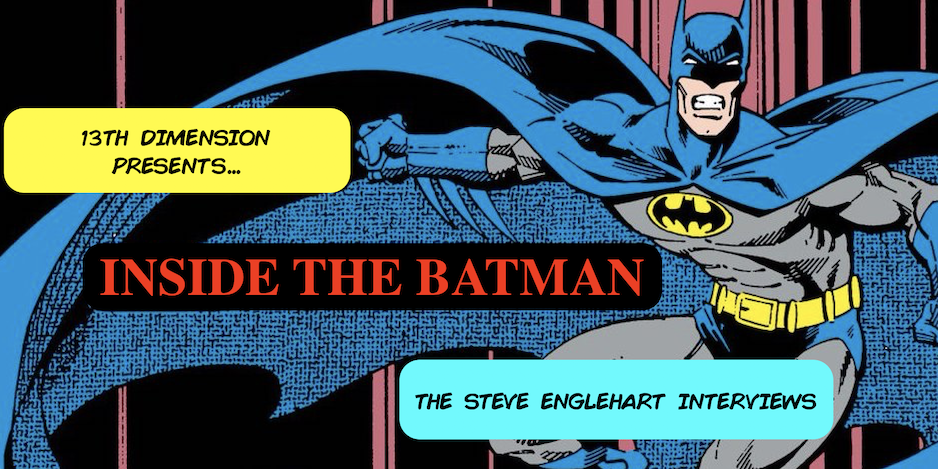
Welcome to INSIDE THE BATMAN: THE STEVE ENGLEHART INTERVIEWS, an issue-by-issue exploration of the greatest Batman story of all time — Steve Englehart and Marshall Rogers’ seminal late ’70s Detective Comics run. The complete story has finally been collected for the first time in hardcover — and in the way Englehart envisioned it — in Tales of the Batman: Steve Englehart. With the book newly released, the time is perfect to go back and look at the story from every conceivable angle. Each weekend for the next couple of months, we’re diving into a single chapter of the 8-issue saga, with full commentary by Englehart himself — the most complete analysis of the landmark storyline ever published. For the INDEX of individual entries, click here.

So far, we’ve covered how Steve Englehart landed the gig, what he set out to accomplish, what his overarching thoughts are on Batman and the Joker, the Darknight Detective’s sex life, the change in art teams from Walt Simonson and Al Milgrom to Marshall Rogers and Terry Austin and how he structured the story. (Click here.) We’ve also explored the story’s first three issues — Detective Comics #469 (click here), Detective #470 (click here) and Detective #471 (click here), which gave us Silver St. Cloud, Rupert Thorne, Dr. Phosphorus — and the return of an obscure ’40s villain named Hugo Strange.
As we move into #471, the art team of Marshall Rogers and Terry Austin is already hitting on all cylinders; Hugo Strange torments Batman and meets his (final?) fate; and Robin arrives to help save the day. All the while, the Penguin and the Joker are lurking in the shadows…
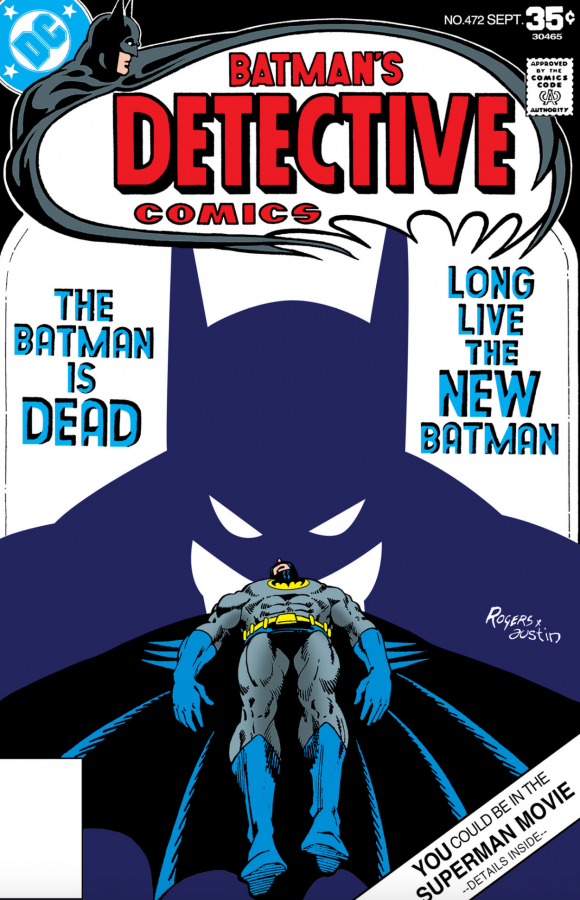
Dan Greenfield: We’re really getting into the middle part of the story here and we have the other classic Batman character: We’ve had Alfred, we’ve had Gordon show up but now we finally see Robin in Detective #472. Was it your idea to make sure that Robin was in it because he was such a classic part of the Batman? Because at the time they were rarely together.
Steve Englehart: When I grew up, it was Batman and Robin. So I’m drawing on my personal thing, where if I’m going to do this, I want one story with Batman and Robin in it. As you can see, I took him from where he was in the DC continuity at the time and I think there’s a line in there somewhere, in this issue or the next, where somebody says oh, well I told Wonder Girl about you, or something like that. (Detective #474.) (Editor) Julie (Schwartz) added that, I didn’t get that far into it. I was trying to be a good soldier here for DC.
Obviously, the whole thing about Hugo Strange becoming the Batman, I had figured all this out by this time. I was not making this up on the fly. I could see where that was going to go.
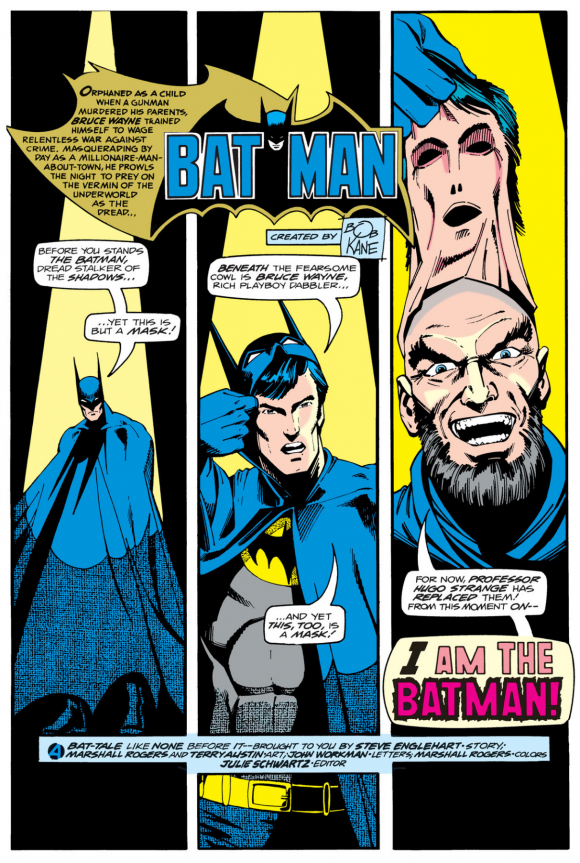
Dan: Before we go back to Hugo Strange, I’ve got something I want to show you here. Before George Perez did him in The New Teen Titans, this might be the coolest that Robin ever looked in that outfit. During the fight, his tunic tears open and he’s got the old fashioned hair from the ’40s. When he’s Dick Grayson it’s more of a ’70s kind of feathered back thing. He’s actually sexy. You wouldn’t think that when you’re talking about Robin, but he is.
Was this something that you had decided? You were very careful in how you wanted all of these characters presented. You wanted the old, but you wanted the new. How much of that concept of the way Robin was, not in terms of the writing, but in terms of the way he was portrayed, how much of that was you and how much of that was Marshall?
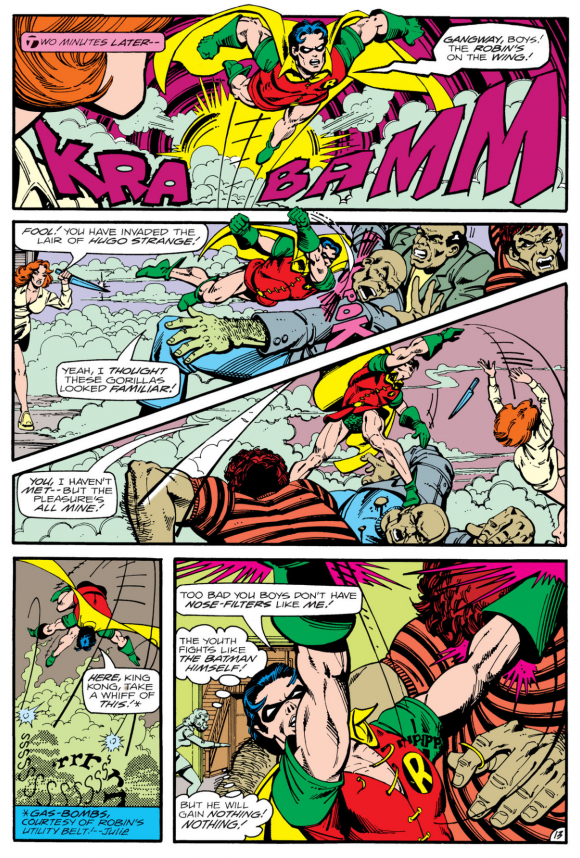
Steve: I would say it started with me, Marshall then took it and went with it. By this point Dick Grayson is supposed to be a teenager, he’s not a boy. I definitely wanted the old look to him, but he’s supposed to have grown up. He’s supposed to be old enough to do that. In the next issue he says something like, “Oh yeah, so you were sleeping with Silver last night, huh buddy?” I mean he’s old enough to do that with this guy, he’s not a boy anymore.
If I had to guess, again I think the tunic pulling open is Marshall; I don’t think that was my idea. Marshall liked that kind of stuff. At the end of the (sequel) Dark Detective run, Batman had had to take off his cowl and his cape in order to wrap up the severed arms of Evan Gregory. Marshall really liked that, kinda coming up with just throw a handkerchief over your head and pretend that you’re Batman now. He liked to kind of, I hesitate to say undress these guys, but I mean he liked to play around with that. I’m pretty sure that was him.
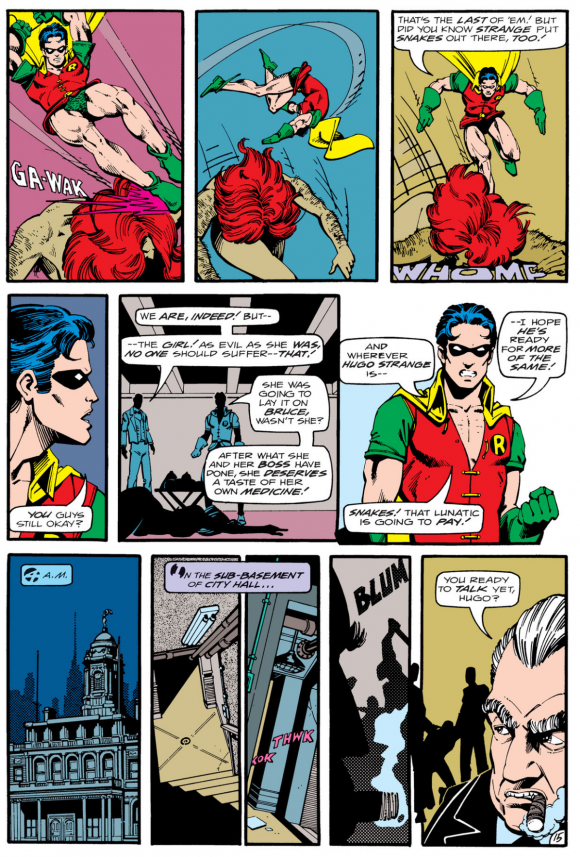
Dan: One of my favorite bits in this issue is when Silver calls Dick, and she doesn’t know him but she knows of him. She knows enough that if something’s wrong, this is the guy to call. What I love is the layout of that page, and that the borders are shaped like telephone wires, the old fashioned kind. Is that Marshall, is that you, is that a combination, or was it something that you saw when you opened it up and said, ‘Holy shit, what a great way of communicating that they’re on the phone?’
Steve: Yes. I’m pretty sure that’s Marshall too. Too bad we can’t be asking Marshall about this stuff.
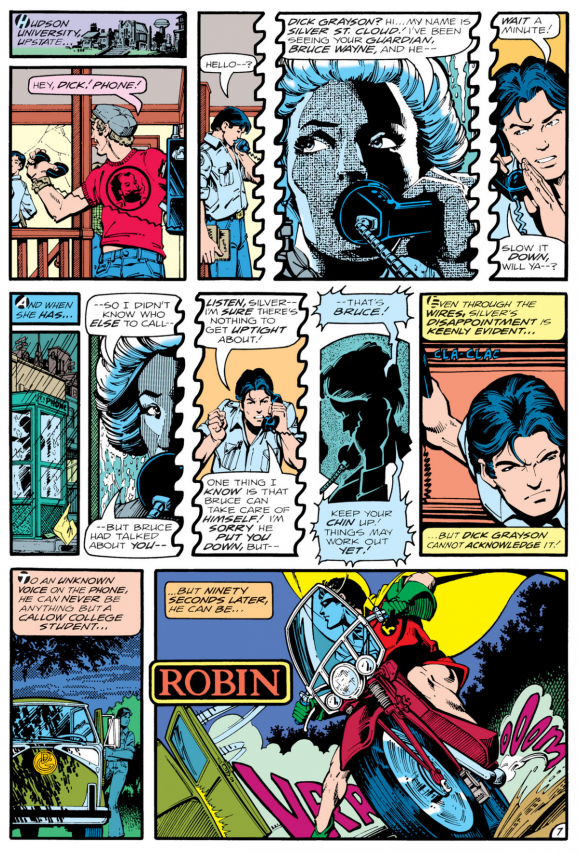
Dan: Of all the people I’ve gotten to interview, that’s my biggest regret — not being able to have talked to him.
Steve: Yeah, so that’s Marshall. I would guess that I probably didn’t write it as eight panels, which it is. I probably wrote it as six or five or whatever and then Marshall’s breaking it up, taking the conversation, splitting it up between the two and putting all the stuff in. This is Marshall, you can see Marshall.
Right across from that, on the page in front of that, Silver’s walking in the rain and the third panel is shot from foot level. Like her leg. That’s Marshall, going, “I’m getting into this now, I can do this kind of stuff” because he understands. I mean… you don’t need to shoot that thing from foot level, but he’s totally on top of it. He’s telling the story and he knows how it’s all going to fit together and how it’s going to look. I love that stuff. Just between the first issue and the second issue, Marshall started to really make this his own thing.
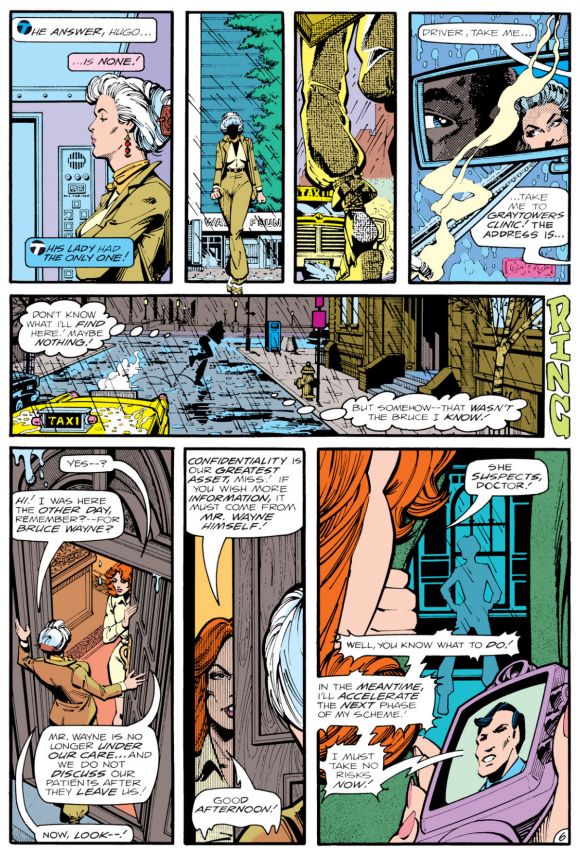
See, I love superheroes. I love doing guys punching each other and flying around doing a lot of stuff. But the thing that I always also love is Silver on the phone with Dick, or something like that. The character things. A couple pages earlier when she goes to see the fake Bruce Wayne up in the building, she’s not stupid! She’s like, there’s something going on here, she knows that. Which is like, light years ahead of any girlfriend that Bruce Wayne ever had before this point.
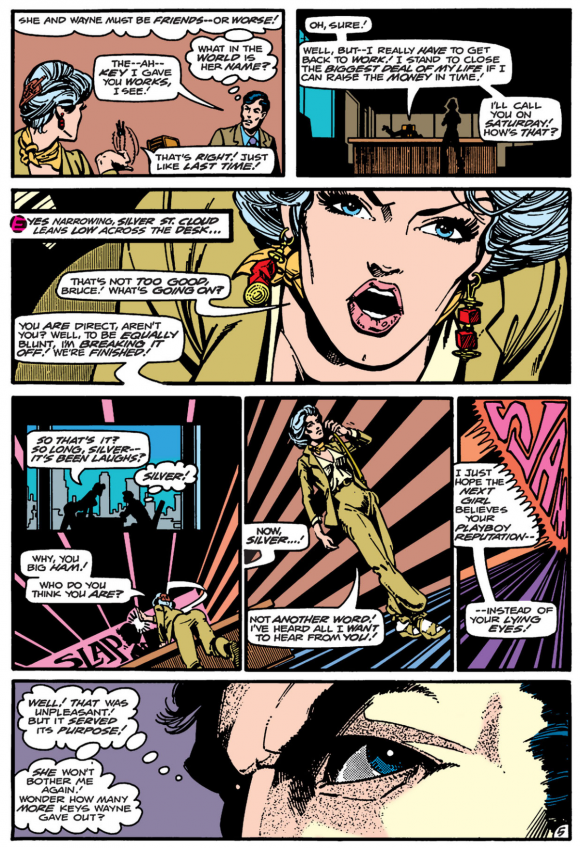
So much of this — I made a point of this lately because of the (1989) movie retrospective and all of that — all this stuff is commonplace now, but it wasn’t then. It was all turning these people into something more than they were, the characters that existed and bringing in new characters. A woman, she’s getting space, she’s part of this story, she’s doing things! Which is unlike any girlfriend at that point. So much of this became the standard after this. This is a new way of doing Batman and everybody goes, “OK, cool, yeah, we like that.” I was just doing it because I liked it and wanted to do something that would be memorable for DC and all that which, every time I get to that point I go, “What an idiot I am.”
Anyway, that was the deal. She’s part of this story, and she’s one of the characters we’re going to be paying attention to. Got to get Dick Grayson in there, and then of course in the middle we’ve got the auction scene at the theater where Hugo Strange is going to sell off his knowledge (of Batman’s secret identity).
It was definitely in the script that I said we can see the cigar, we can see the umbrella, we can see the purple foot. “I want darkness.” And we don’t know, but I figured a lot of people are going to be able to figure this out, and they’re going to think it’s kind of cool. That’s doing darkness, that’s doing Bat-darkness stuff. And Hugo Strange says, I’m outta here, and the panel is completely black! He just, good night and then he’s gone in the darkness.
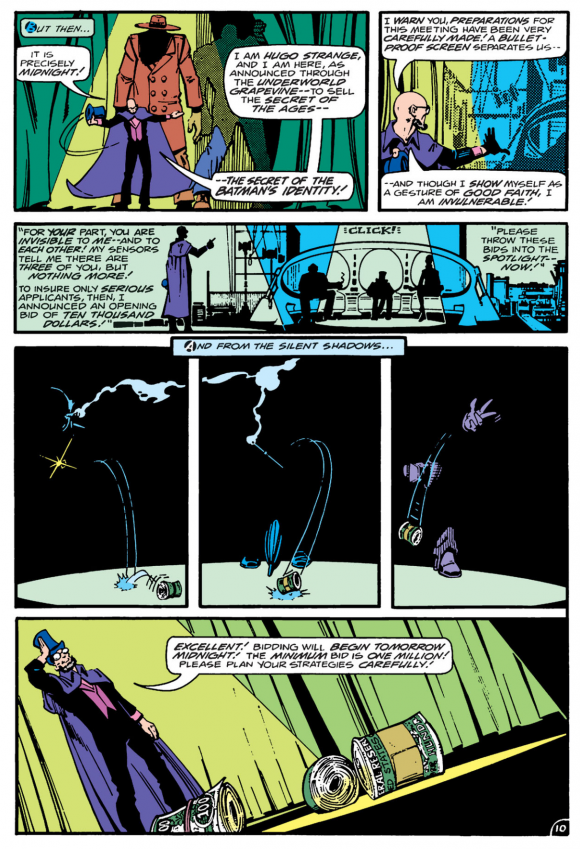
Dan: From a storytelling standpoint it’s great foreshadowing. You’re giving Easter eggs of what’s to come, because at this point we haven’t seen the Joker and the Penguin. We’ve seen Thorne so we recognize his ring. Especially when we see the ring in that first splash page of the previous issue where he’s slamming the table and then there from a distance you see a kind of twinkling in what little light there is, and the cigar. Then all of a sudden it’s like oh hold on, Penguin and Joker are hanging around here now too. This is now going to go in a different direction, which I always thought was an extremely clever way of introducing them into the story.
What I also like about what you did specifically with Hugo Strange is that you put a spin on his character about his obsession with Batman — not just that he wanted to defeat Batman but that he wanted to become Batman. This idea that there was something psychological here that was beyond what you would have expected from this character. That throughline play all the way to the end of this issue, when he refuses to give up the name. Talk about what your thinking was about Hugo Strange here.
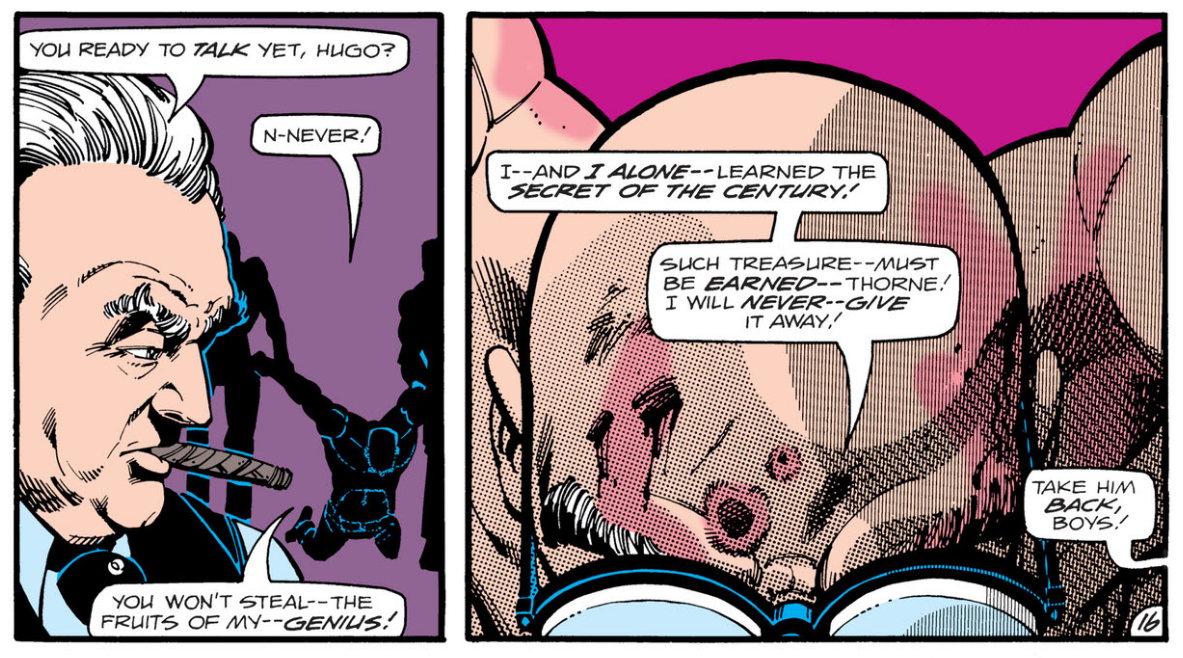
Steve: OK, well, again Hugo Strange is there because I swiped him from the ’40s, and he had monsters and he was a weird scientist guy. Then it becomes incumbent about, well, what are you actually going to do with him? So that’s me sitting there going, OK, I put this whole thing together, Hugo goes in this direction, will that work? How is that going to happen? He became more human, he became a character.
I remember when I started writing for Marvel, I remember standing in the shower one day, about to write whatever I was going to write, and I was standing there thinking, “What is the super villain’s plan?” The super villain thinks he’s going to make this work. It’s not going to happen. He’s going to lose, but he’s got to have some sort of plan. So, from a very early thing, I was always thinking about all the different people in here, even if their plan wasn’t going to come to fruition. I don’t want to just write strawmen, I don’t want to just write a guy in a costume and say, “Oh he’s big and scary” and then the hero beats him up.
I want to know more about him, and it varied over time but I definitely wasn’t going to just replicate anything. I wanted to take the cool stuff and then figure out what I could do with it. Part of that was giving him that character.
Certainly from a logistical standpoint, he has to be somebody that we really think, “Oh, this is a cool guy. He’s doing cool stuff,” but he’s not as cool as the guys who are sitting there in the shadows. He’s going to have to hand the story off to them, right? So that was how I got to the part about him coming to an end in this issue.
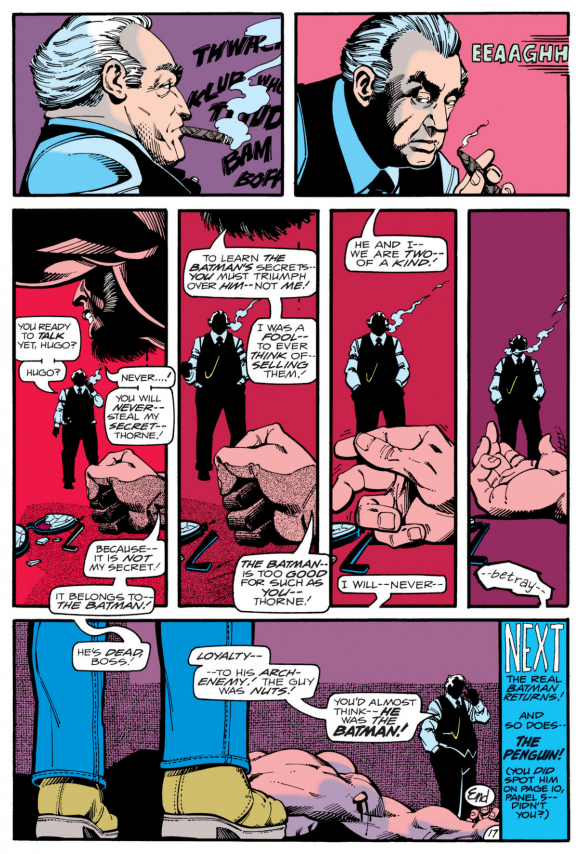
The thing there was that I had written this story where they beat him to death “on camera.” Julie was the guy who said, well I think it would work better if it was done off camera. Fine! I definitely have my ideas about what works and what doesn’t work and if I’ve worked it out in my head, I’m not a big fan of people saying, “Well, change something.” It’s like, nah I don’t really want to change something! Because I already figured out how it’s going to work.
But that didn’t affect anything, whether it was on-panel or off-panel. I think that was probably Julie’s coming from the ’30s and ’40s, that you weren’t going to beat somebody to death on screen. But he said to me it would be more effective if you did it off screen and I was happy to accommodate. Julie and I got along fine, I mean he didn’t try to rein me in and neither was I trying to kick him in the balls just to show that I could or anything. If he had an idea I was perfectly willing to listen to it and utilize it if I thought that it would make sense within what I was trying to do, which this did.
As far as anybody’s concerned, let me just say, Hugo Strange is fuckin’ dead here. I don’t care if they brought him back and explained it — I hadn’t even thought about the ghost at this point. The ghost was still to come, but he’s dead. He’s not coming back. No one in comics is ever really dead but this guy’s dead.
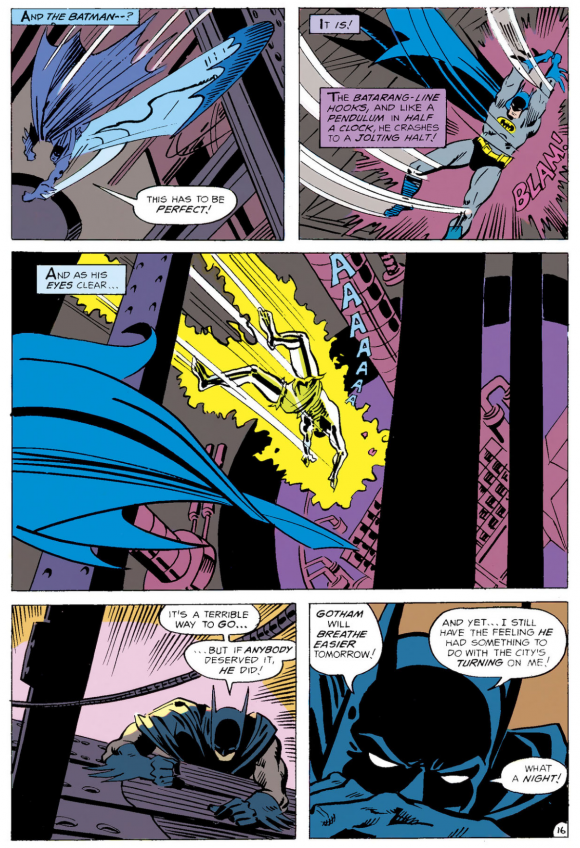
Detective Comics #470. Art by Walt Simonson and Al Milgrom.
Dan: With Doctor Phosphorus you gave him the classic villain death where he dies in an explosion and we’re presuming that he’s dead. Here you actually see a dead body, and that’s very rare in comics. At which point did it turn in your mind that you wanted to bring him back for the second half of the story as this ghostly figure? Because that to me was unexpected, because Batman always kind of went up to the line of supernatural, but always stayed just in the line of reality. At what point did it click in your mind, “Hold on a second, I’m not quite done with him yet and I’ve got some ideas.” Where did that start to change?
Steve: As I’m plotting all these different things, trying to draw them all together for a big finale at the end of the certain number of books I had… I didn’t really have an ending for Boss Thorne. Boss Thorne was a bad guy, he was there, he was doing things, but Hugo Strange had to hand things off to the Penguin and then the Joker, so it’s like “Where’s Boss Thorne fit into all of this?” What can I do with him that can somehow get him on the same level, make him as entertaining to watch as these other guys?
Basically, I stole that whole idea unapologetically from Dick Tracy. Dick Tracy, when I was a kid, Harvey Comics was republishing Dick Tracy stuff and I could go on for a long time about all the cool Dick Tracy stuff that I loved as a kid. As a kid I loved Dick Tracy, I loved Batman — you can see what interested me.
Tracy of course was a realistic police drama, except all the villains were Batman villains, right? Before there were Batman villains, there were Dick Tracy villains. Batman probably stole it from Tracy. So, Tracy has dozens of classic villains.
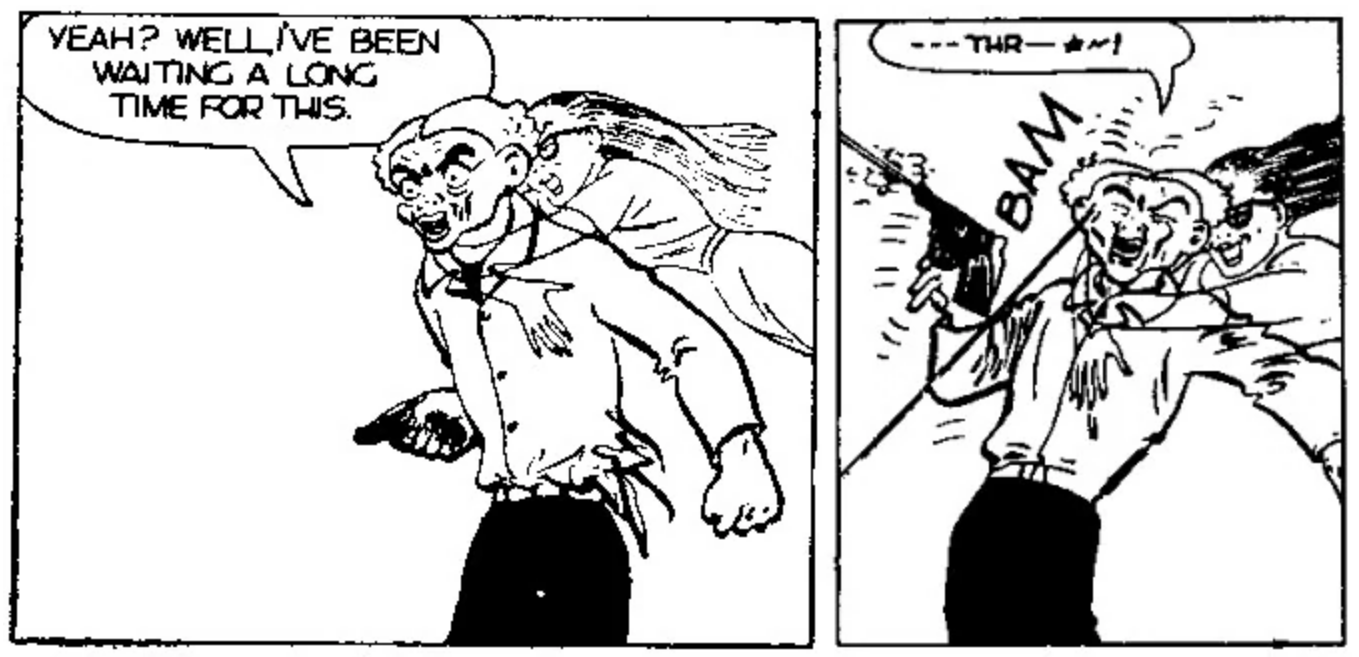
Flattop was a famous Dick Tracy villain. Great, great Dick Tracy villain. And then enough time went by in real life that Gould decided to do Flattop Jr. who was a juvenile delinquent in the ’50s. In any event, he’s with this sort of wise young girl named Skinny, and he eventually kills her, and then later he’s haunted by her; her ghost comes and haunts him. That all seemed legit to me to do in Batman. It had been done in Dick Tracy. I’ve never tried to cover that up, that’s where I got the idea. I thought, wouldn’t that be cool if the ghost of Hugo Strange was now hanging around and it all ties up Boss Thorne nicely?
As you say, the idea that Hugo Strange is actually dead and that this is actually a ghost — that’s not traditional Batman stuff, but I thought it could slip in the door. It could fit in Batman’s world. So, there was never any explanation. I mean in the end he wants to point something out to Batman that will help Batman win this battle with the Joker because Hugo Strange admires the Batman, and he does that.
As far as I was concerned, when you’re writing comics you know that somebody’s going to be there next month continuing from where you left off. So, I can’t ever say, “Well, I did it and nobody else ever gets to do it again” or any of that kind of stuff. At least in my head, Hugo Strange was definitely dead and the ghost was just part and parcel of the weird world that Batman lives in. All this stuff later about “he wasn’t really dead” and “he faked the ghost” and all that is like, yeah, go away.
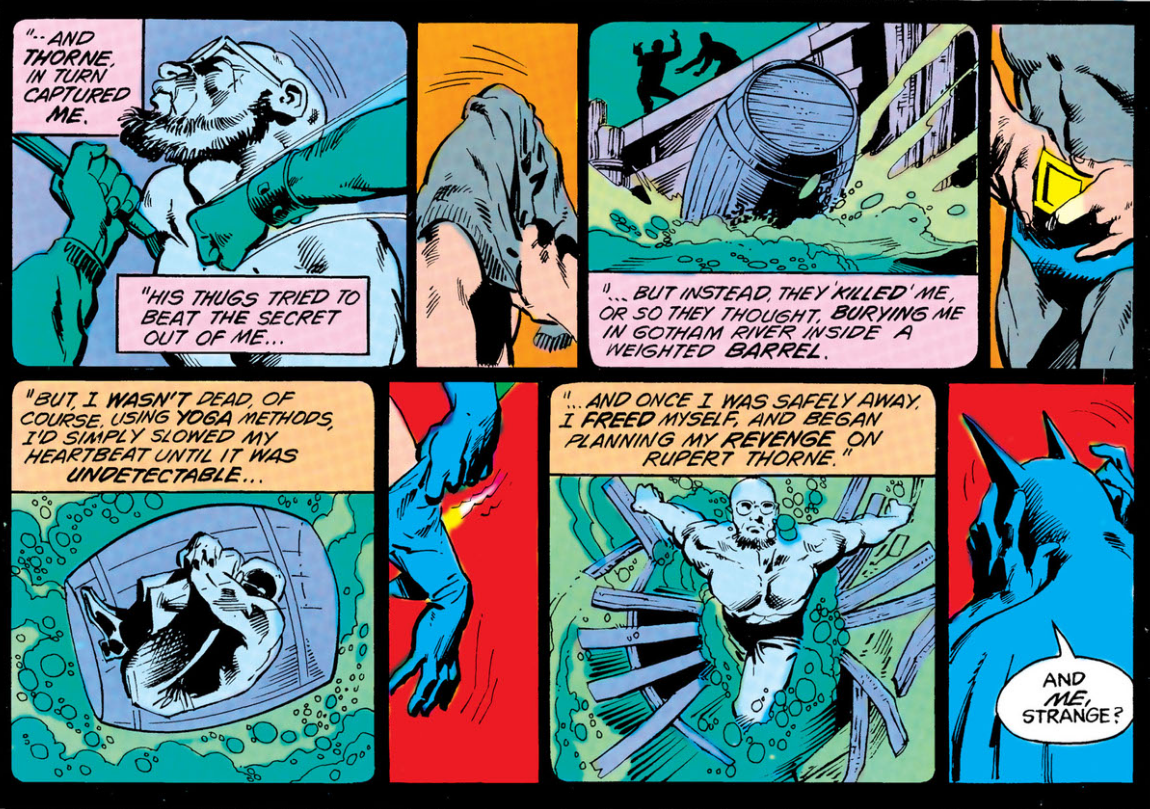
Batman #356, publication date Feb. 1983.
Dan: He’s become, after having been absent for 37 years, one of the main villains that you see pop up all the time, whether he’s in a supporting role or the main villain. He shows up in animation, he shows up on television. None of that would have been if not for what you have done, because nobody was doing it before then. Do you have sort of mixed feelings about that, or is it something that’s gratifying to you that you basically made this character into something that had legs?
Steve: There’s two different answers to that. As a professional comic book writer, I take pride in having done that sort of thing. As a professional comic book writer who works for DC Comics, where they say, “You didn’t invent him so you don’t get any credit or money from it!”… Same with Guy Gardner (whom Englehart also redefined), same with the movies, all that kind of stuff… being dissed by DC, I don’t like it, that’s why I don’t like DC. They’ve had 45 years to come around.
Guy Gardner was another one of mine. DC goes, “Nope! There was a Guy Gardner before you did it, so even though he’s a completely different character and he’s extremely popular and he was completely moribund and useless before you got here, you don’t get anything for it.” That’s DC, and that’s why I don’t like DC.
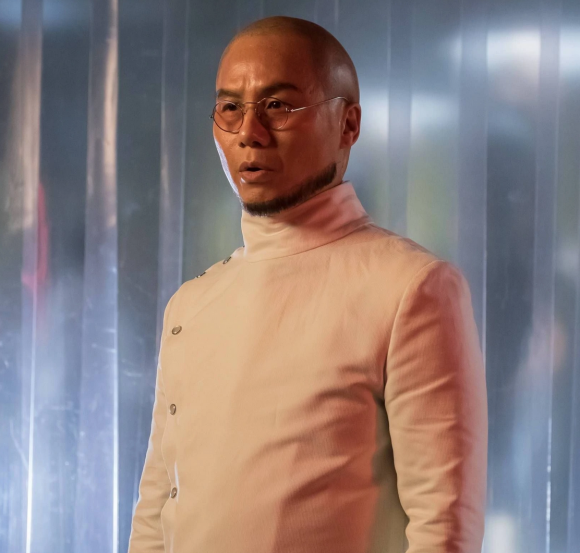
BD Wong as Hugo Strange in Gotham
Dan: Neal Adams has complained about the same thing about John Stewart, where he created John Stewart — whether he created him with Julie Schwartz and with Denny O’Neil or whatever — they’re like, “No, no, no he’s just another Green Lantern.” And he’s like no, “I took a totally different spin and I should get credit for that.” I understand that complaint and that conflict.
Steve: You can put in a request at DC to get character equity on things. Joe Staton and I put in for Kilowog and for Guy Gardner, and DC came back and said pretty much the same thing, “Nah, they’re just Green Lanterns, they’re all Green Lanterns, you don’t get anything.” But Kilowog blew up so quick that they did backtrack on that, they came back six months later and said, “Oh OK, I guess he’s somebody. So yeah, you can get paid for Kilowog.” Why that doesn’t apply to Guy Gardner…
Dan: Probably in their minds because Gardner was a pre-existing character. He had been introduced in the ’60s even if he’d only shown up once or twice. I would imagine that’s what their take is. Kilowog you guys created out of whole cloth.
Steve: Right, but as I always say if I had taken the Guy Gardner character and called him Joe Smith, I’d be a millionaire today. Not exactly. But just because I was trying to be a good soldier, I said, “Oh this was that guy that was hanging around in Green Lantern continuity.” And cost myself a lot of money and credit! And DC had never felt like they needed to do anything, for me or anybody else.
—
NEXT: PART 5, DETECTIVE COMICS #473 — The Importance of the DYNAMIC DUO — and THE PENGUIN. Click here.
—
MORE
— INSIDE THE BATMAN: THE STEVE ENGLEHART INTERVIEWS Complete INDEX. Click here.
— PART 3: DETECTIVE COMICS #471 — ‘THANK YOU, GOD’: STEVE ENGLEHART Recalls First Seeing MARSHALL ROGERS’ BATMAN Art. Click here.
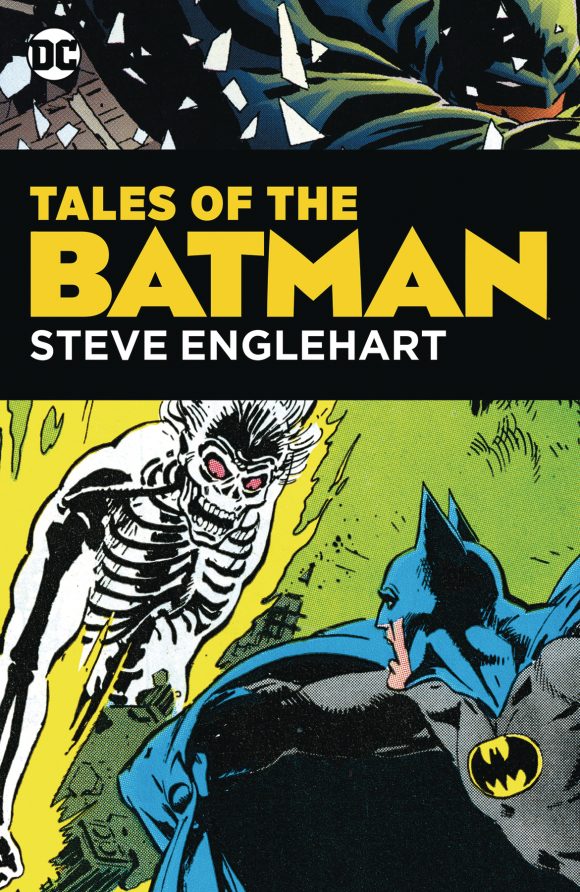

July 19, 2020
I so appreciate how in depth Mr. Englehart is with his answers.
July 20, 2020
Another great installment– interesting that it was Marshall’s idea to have Batman lose his mask in the Dark Detective series, that was one point of that storyline I really disliked– the handkerchief as a mask thing just seemed silly.
July 21, 2020
About the Robin stuff, I agree that this was a precursor to the New Teen Titans stuff. and one of the better Dynamic Duo stories. It’s too bad that Englehart and Rogers never did a story with Catwoman or Poison Ivy. The one in the Batman newspaper strip had a different writer.
July 23, 2020
These are definitely some of Dick Grayson’s greatest Robin moments in a Batman comic. Dick is portrayed as a completely capable and competent hero, one who has his mentor/partner’s back. I wish all writers would remember THIS is the way the Dynamic Duo should be portrayed.
Loving this series!
Chris
August 1, 2020
Very informative entry. I’ve always wondered if Steve Englehart meant for Hugo Strange to be “really” dead… and now I know the answer.